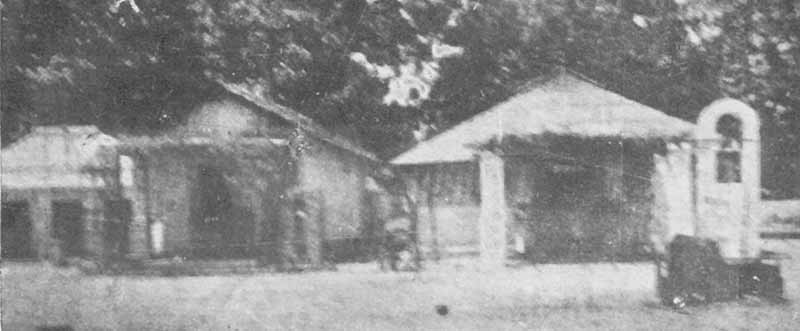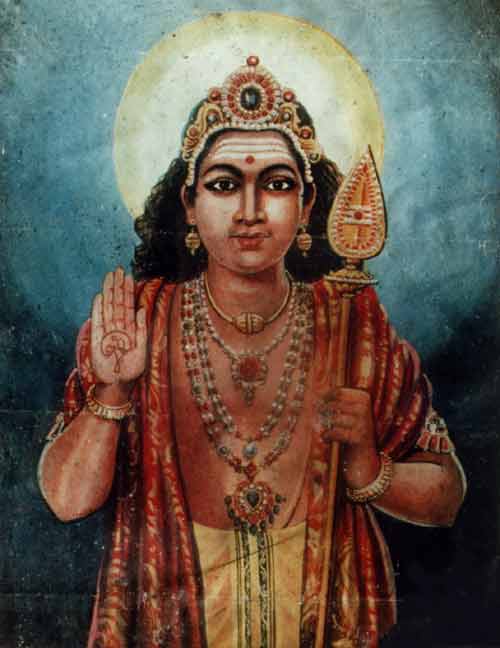|
| |||||||||||||||||
 The Origin of Ruhunu Mahā Kataragama Devālayaand the role of Mahāsammata and Rājakāriya in Sri Lankan historyby Patrick Harrigan and Manik Sandrasagra
| |||||||||||||||||

|
1935 archival photo (left to right): Ganapati Kovil, Maha Devale, Teyvani Amman Kovil gate |

|
|
Kataragama devales as they appeared in 1950
|

|
Kataragama Divya Rajottama |
Historically, Kataragama has always maintained a low profile. While this may strike some as a rationalization for the near-absence of Kataragama from history books, it should also be borne in mind that, in principle, the hero or god-king of Kataragama is one who achieves his aim through subterfuge, disguise, and stratagem. To wit, he is a god of wits, humanly accessible to those who apprehend his modus operandi. This should tell something about where he is to be found, and how.
Historical suggestions of the Kataragama myth appear in Sri Lankan history as early as the late centuries before the Common Era, leaving little room for doubt about Kataragama’s antiquity which, according to oral tradition still preserved in Kataragama, predates the appearance of either Sinhalese or Tamil culture in Sri Lanka. The most notable historical example from this period is the epic struggle between two famous Sri Lankan kings, Elara and Dutugemunu.
Kings Elara and Dutugemunu
Modern historians, and Sinhalese chauvinists in their turn, have sought to emphasize the ethnic dimension of this episode, portraying it as the patriotic struggle of Sinhalese nationalists to expel or exterminate the Tamil inhabitants. In doing so, they have performed a great disservice to Sri Lanka, but that is not the point here.
Criticism has been leveled against these same people for conveniently overlooking the fact that King Elara, whether he was a Tamil speaker or not, was also one of Sri Lanka’s most respected monarchs, serving a reign of forty-four years that was noted for its impartial justice and patronage of various faiths, including Buddhism. In fact, it was Elara’s unswerving dedication to justice that settled his end, for he found himself duty-bound to order the execution of his own son and heir-apparent, who had recklessly caused the death of a cow, a capital offense in those days. Unable to abdicate without a successor, Elara’s utmost concern at his age would have been not to maintain himself on the throne at any price, but to heal this disruption in the natural order by allowing for a just and natural succession, at the cost of his own life.
Considered in this context, the events that followed acquire added significance. In Ruhunu, young prince Duttugemunu vowed to god Kataragama to fight for justice and the cultural integrity of Sri Lanka. Symbolically, this act set in motion the epic events that were to follow. Duttugemunu was then able to raise a large army and march successfully, battle lance in hand, against the petty chieftains who stood between him and Elara. By the time the young prince and the old king faced each other on the field of battle, the overtones of their symbolic encounter would have been fully evident to both of them, if not to others as well. Duttugemunu had to come out victorious, just as Elara must have welcomed this opportunity to end his life in battle. Never was the outcome in doubt, as far as they were concerned.
In a sense, Elara’s sacrifice was Dutugemunu’s triumph, and together they restored the ancient symbolic order in a spectacle that was as mysterious as it was dramatic. Undoubtedly, the whole affair left a deep impressions upon Duttugemunu, not to mention Sri Lankan consciousness ever since. Out of gratitude to god Kataragama, and in fulfillment of his vow, Duttugemunu decreed that hence forth and in perpetuity a vast grant of populated and rich land in Ruhunu would be given over to the sovereign authority of god Kataragama himself. Further, to insure that the traditional rites would also be carried forth on behalf of all posterity, he stipulated that they be partitioned into 505 ritual assignments, or roles, to be annually performed in accordance with the tradition of ‘royal service’, or rājakāriya, and passed on from one generation to another in perpetuity.
Time, encroaching jungles, and successive governments have cheated Dutugemunu’s intentions, but through an ingenuous redundancy of tasks, the essential performance still survives today, even if scaled down by centuries of attrition, misunderstanding, and official neglect. In a sense, the king-less kingdom of Kataragama is yet extant, and very much alive in the hearts of his subjects. What can be more low-profiled than that?
Mahāsammata and Rājakāriya
To understand the interplay of abstract concepts and the unfolding of history, it is essential to grasp the role of what is called mahāsammata, or ‘common consensus’. Because it was common to all, it was the called mahā, ‘great’. The sam-mata ('agreement' or 'consensus'), was not a public scheme or policy, but the articulation of the common interest: it was the ‘common sense’ of those days. Truly effective policy, or what our contemporaries call ‘power’, was understood to devolve from higher principles, or Dhamma. The analogue in the human domain was the king – or sometimes queen – whose authority to reign depended upon adherence to Dhamma. Principles reigned, rather than individual interests, so unanimity of opinion was natural.
One example of this mahāsammata in Sri Lankan history is as follows. The island largely consists of what has been called a hydraulic culture, where seasonal rains must be supplemented by irrigation to assure adequate crops of rice. Large-scale irrigation requires the construction and maintenance of wewas, bunds for the purpose of gathering the seasonal rains for distribution as needed. These enormous irrigation works, many of which are still functional today, were built and maintained through the institution of rājakāriya, whereby each household agreed implicitly to give manual service to the king in return for an allotment of life-giving water.
The reign most famous for the creation of these great bunds was that of King Mahāsena, whom historians assign to the third century C.E. It is noteworthy that this king should bear one of the names of god Skanda, Mahāsena (literally, ‘who has a great army’), as it is not for military exploits that King Mahāsena is best remembered. Rather, Mahāsena was a king whose inspired leadership served not only to insure the nourishment of his people, but to help forge their sense of common identity as well. In other words, the ‘great army’ he raised consisted of every man, woman and child in the kingdom, armed with a common consensus. Whatever Mahāsena’s personal peculiarities, he remained the living symbol of his people’s Mahāsammata. This is close association of King Mahāsena with the concepts of Rājakāriya and Mahāsammata is crucial to a genuine understanding of the traditional perspective: Rājakāriya was Mahāsammata applied in social practice, the performance of which embodied timeless principles and maintained the kingdom's balance and prosperity.
Kataragama according to an old Indian print
![Kataragama according to an old Indian print [47 kb]](../pix/old-kataragama-print980.gif) |
||
| ||
|
|
|
| Living Heritage Trust ©2021 All Rights Reserved |